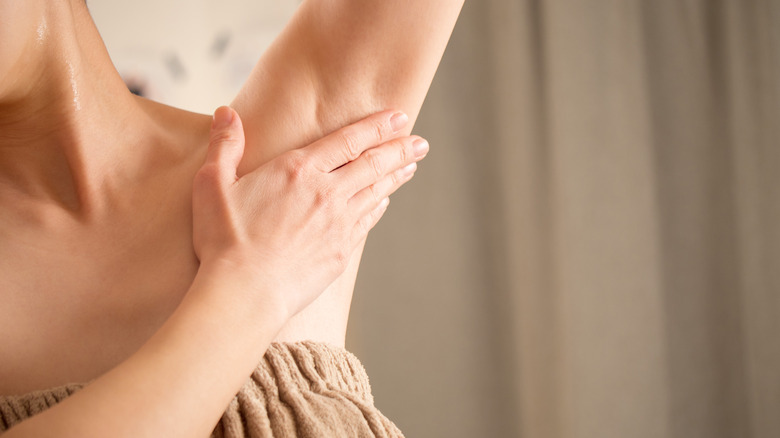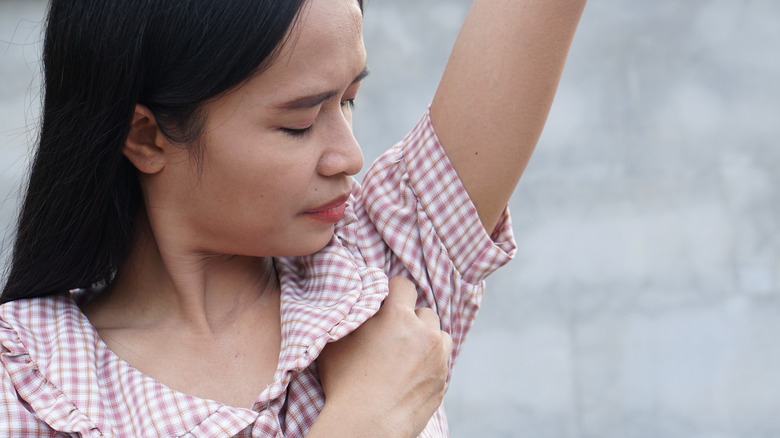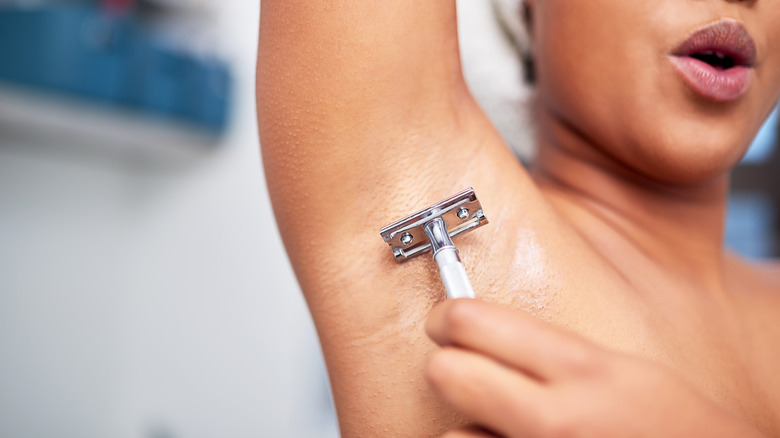Armpit Breakouts Aren't Always Pimples - Here's What To Know
We put our underarms through a lot. From shaving and waxing to using deodorants and antiperspirants, our armpits can suffer. Even those pits that never come into contact with hair removal or some type of deodorizing substance can still be dealt with a handful of issues — not only because the underarm skin is sensitive but because it holds a lot of moisture and sees quite a bit of action with the putting on and taking off of clothing.
"Some big differences [between underarm skin and other parts of the body] are the fact that the area itself is high in humidity, that it is constantly exposed to friction from two closely opposing surfaces and that it differs in its concentration of hair follicles and sweat glands," board-certified dermatologist Dr. Julie E. Russak told Today. "All of these factors contribute to a different microbiome population of the axillary skin and its behavior."
Because the underarm skin can be so precarious, we can't be completely surprised when it acts up with pink bumps, rashes, breakouts, and other irritations. When this happens, it's important to realize what you're dealing with so you can treat it accordingly. Just because it looks like armpit acne doesn't mean it always is. It could be a handful of other things instead.
Furuncles (aka boils)
We have bacteria all over our bodies. According to the National Institutes of Health, there are trillions of these microorganisms that call our bodies home. This bacteria is paramount to human health. But because there are so many, inevitably, the good bacteria might occasionally come in contact with a toxic bacteria, and then what follows can be an infection. One bacterial infection that can occur under the arm is called furuncles, which, let's be honest, is a fantastic name.
Furuncles, also known as boils, are caused when a "hair follicle and the surrounding tissue become infected," according to a study in InformedHealth.org. As a result, a "pus-filled bump" appears. The bacteria that are often associated with these infected armpit bumps is Staphylococcus aureus bacteria, more commonly known as a staph infection. Although the study found that some of these infections go away on their own, seeking medical treatment can help speed up the process, with prescribed antibiotics sometimes proving necessary.
If you have bumps in your armpit (although they can appear anywhere on the body) that hurt and look pus-filled, the best thing you can do, if you choose to skip the doctor's office, is leave them alone. It may be tempting to squeeze them, but in doing so, you risk spreading the bacteria on your skin or pushing it down through the infected hole into the blood. According to the Centers for Disease Control and Prevention, over 119,000 people had bloodstream staph infections in 2017, and almost 20,000 of those people died.
Yeast infection
Although we tend to think of yeast infections as something that can only happen in the vagina, yeast infections can actually pop up anywhere on the body. As long as there's a warm, moist environment to welcome the growth of yeast, it can show up and wreak havoc (via Medical News Today).
Yeast that grows on the skin is a fungal infection called candidiasis and is a very itchy, red rash surrounded by bumps that can look like pimples. In addition to the moist area under your arm being a factor in these infections, tight clothing, hot weather, general lack of hygiene, and not changing or washing your clothes often and thoroughly enough also can contribute to this build-up of yeast, per Cleveland Clinic.
While there is a chance that a yeast infection in the armpit can clear up on its own by keeping the area dry, it likely will take a bit of TLC to help. Because yeast is a fungus, it likely will need to be treated with topical antifungal medication that you can get over the counter. If the infection persists, a doctor can prescribe an oral medication that will clear it up much faster.
Contact dermatitis
Trying to figure out if you have contact dermatitis can be difficult. Not only can it look different based on the irritant or allergen that the skin came in contact with — from scaly skin to lesions — but the reaction can appear at any time. "The more people are exposed to an allergen the more likely they are to develop contact dermatitis in response to that allergen," dermatologist Jeff Yu tells the National Eczema Association. "For example, people with body piercings have a higher likelihood of developing contact dermatitis in response to nickel compared with people who do not have them."
Suddenly, the deodorant or detergent you've loved and used for years can be the culprit of an irritating cluster of itchy bumps under your arm. And, because it's something you've used for so long, it may take a while to realize the source of the problem.
The best way to avoid contact dermatitis is to avoid known irritants, which could be creams, deodorants, perfumes, dyes, certain fabrics, metals, and soap — both body and clothing detergent. Although over-the-counter products like hydrocortisone cream can help, because it might be hard to determine if it's actually contact dermatitis, you may have to pay your doctor a visit.
Folliculitis
Visually, furuncles may look like folliculitis, but there is a key difference between the two. Furuncles is an infection that "goes into the deeper layers of skin," according to Cedars Sinai, whereas folliculitis is when the hair follicle becomes infected and remains at the top layer of skin. There are several different kinds of folliculitis, per Healthline, with links to razor burn, hot tub rash, and fungal and staph infections.
As you would with furuncles (or any skin irritation, for that matter), you want to restrain yourself from picking at the bumps and let the infection run its course. According to Healthline, "most types" of folliculitis aren't contagious and are relatively harmless, albeit uncomfortable and painful.
If it looks like the folliculitis isn't going away or is getting worse, a trip to the doctor may be necessary. A healthcare professional can prescribe a medication that can usher along the healing of the infection. You definitely want to refrain from shaving until the infection is gone.
Hidradenitis suppurativa
As you've seen, when it comes to underarm breakouts, the cause can really run the gamut. But if you tried to treat the irritation with over-the-counter products like steroid ointments or antifungal creams and nothing has worked, it may be time to see a dermatologist. Not only do you want to put the itchy or painful bumps to bed, but it could also be something a little more debilitating, like hidradenitis suppurativa.
Hidradenitis suppurativa (HS) is also called acne inversus because the lumps are under the skin. According to a 2023 review published in StatPearls, HS is most common in women in their 20s and usually pops up under the arm or in the groin area, among other areas. Genes, behavior, and environmental factors are linked to HS, with obesity, smoking, hormones, and genetics mentioned in the review as potential factors. Antibiotics are often "the first line treatment." In some cases, surgery may become necessary to drain the abscesses.
No matter what's going on in your armpit, there's likely a good explanation, and it's not always pimples. While self-diagnosis can be helpful, it can also have you running around in circles with different OTC products. Sometimes it's best to skip that mayhem and go to a doctor and have it checked out, especially if your so-called "pimples" are really painful.



